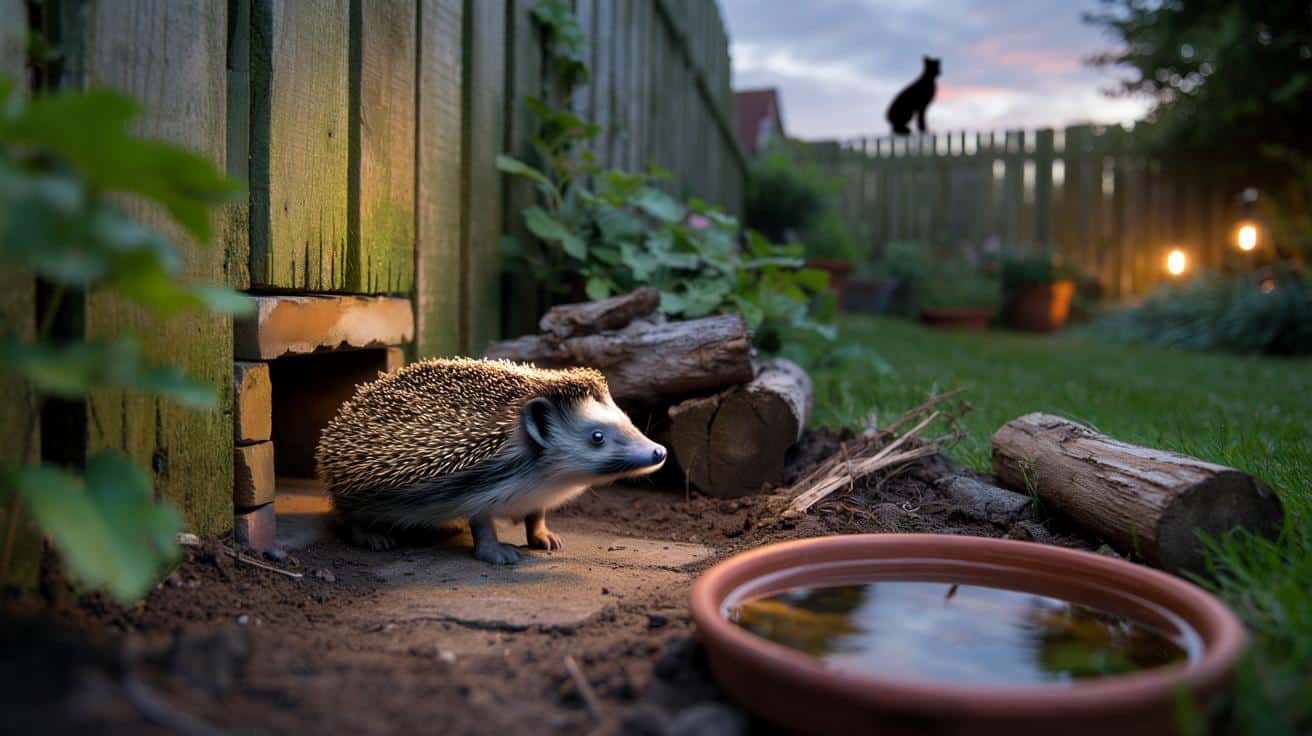Fewer snuffles under the shrubs, fewer tiny pawprints in the mud. Many people rush to buy shelters or fancy food, thinking it takes money to bring wildlife back. It doesn’t. The simplest fix costs nothing and starts with a gap no bigger than a paperback.
The evening I noticed it, the street lights were just flicking on and the neighbour’s cat was doing its slow patrol. A hedgehog appeared where I didn’t expect one: nose first, then a round body rolling through a thumbed corner of fence where the panel didn’t quite meet the soil. It paused, sniffed, and toddled past me like I was a lamppost, straight towards the compost heap. We’ve all lived that moment when a wild creature picks your place and you feel oddly chosen.
I didn’t bait it. I didn’t buy anything. I simply stopped sealing the borders. That tiny gap was an open door.
Open the fence: the £0 hedgehog highway
The trick is almost embarrassingly simple: create a small ground-level opening between gardens so hedgehogs can roam. Gardeners call it a **hedgehog highway**. It’s a 13cm square hole (about CD-sized) at the bottom of a fence, gate, or gravel board, or the space made by lifting a brick. It costs £0 because you don’t need to install anything new. You’re removing a barrier, not buying a gadget.
This works all year because hedgehogs need to travel widely for food in summer and to find safe nesting spots in autumn and winter. They wander one to two kilometres a night, zigzagging like curious vacuum cleaners. Seal a garden and you turn a rich neighbourhood into a dead end. Open one little portal and you link dozens of feeding grounds, fresh water dishes, leaf piles, and quiet corners into a lifeline grid.
Think of it like rights of way for wildlife. A single hole in your fence is helpful; a street’s worth of holes becomes a network. Food sources change with the seasons, and so does shelter, so connectivity beats any single feeder or house. When hedgehogs can slip between plots, they avoid roads, find mates, top up on beetles and worms after rain, and tuck into dry nests during a cold snap. It’s low-tech, low effort, and wildly effective.
Make one tonight: how to open a no-cost gateway
Find the spot hedgehogs already test. Look for scuff marks along a fence line, a faint trail under shrubs, or a spot where the soil dips. If you have a gravel board, shift one loose brick sideways to create a 13cm gap. No brick? Nudge the soil down to form a shallow arch under a fence panel. You’re making a mouse-hole for a prickly football. That’s it. *Yes, a humble gap can be a lifeline.*
Let’s be honest: nobody refreshes every water dish or tidies every leaf pile every day. Make your garden forgiving instead. Keep one “wild corner” where leaves and sticks can settle into a snug nest. Add a shallow plant saucer with **fresh water** near cover and top it up when you remember. Skip milk entirely—**no milk**—it upsets hedgehog stomachs. If you feed, stick to meaty cat or dog food in jelly, and only at dusk, then clean dishes so you don’t invite rats.
People worry about predators or mess. Fair. Hedgehogs are surprisingly streetwise for something shaped like a pom-pom, and they choose cover. Keep gaps hidden behind shrubs, not open lawns. Lift netting off the ground and flatten any open loops of string. Avoid slug pellets with metaldehyde; use hand-picking, beer traps, or organic ferric phosphate if you must. They’ll still come if your lawn isn’t perfect.
“If every garden on a terrace cut one hedgehog hole, we’d halve the distance these little guys walk on roads overnight,” says a volunteer rehabilitator I met in a church hall pop-up clinic. “It’s the cheapest conservation you’ll ever do.”
- Size guide: aim for a 13cm x 13cm opening at ground level.
- Best place: under fences, behind plants, away from dog runs.
- Year-round help: water dish, leaf pile, log stack, pond exit ramp.
- Never: milk, bread, uncovered drains, loose netting, strimmers in long grass.
- Neighbour nudge: a friendly note through the door doubles your impact.
Why a gap changes everything
A closed garden is tidy for us and tricky for wildlife. A small opening tells hedgehogs there’s a way through, then your borders, paths, and scent trails do the rest. Once one hedgehog maps your place, others will follow the route later in the season, like buses following a timetable only they can read. You’ll start noticing bent grass blades, tiny droppings, and night-camera cameos that turn late news doomscrolling into a check-in with your local stars.
There’s an unexpected social ripple too. The moment you make a gap you start talking to neighbours. Someone remembers the hedgehogs from the 90s. Someone’s child gets to set a wildlife cam and runs downstairs at breakfast. The whole street quietly shifts. A fence stops being a wall and becomes a shared hallway. No one needs permission to care, and no one needs a budget. It’s just a gap—and a bit of trust.
Winter doesn’t cancel the trick. It makes it more valuable. Hedgehogs move nests between cold snaps, especially young ones, and a connected chain of safe corners keeps them off the road and out of trouble with strimmers and bonfires. In spring, the same gap becomes a route to water during dry spells, and in summer it’s a corridor to beetle buffets after warm rain. One change, twelve months of benefit.
So, yes, you can buy a hedgehog house and a night-vision camera and all the rest. You can also spend nothing and make the most useful feature they’ll ever need. £0, five minutes, one small opening. And if you’ve already got a loose panel or a gap under your gate, do nothing at all—just leave it, deliberately. The smartest wildlife gardening sometimes looks like laziness. It’s not.
| Point clé | Détail | Intérêt pour le lecteur |
|---|---|---|
| Hedgehog highway size | 13cm x 13cm gap at ground level | Easy to action tonight, no tools required if a gap already exists |
| All-year benefit | Access to food in summer, nesting routes in autumn/winter, water in dry spells | One step supports hedgehogs across seasons |
| Zero-cost extras | Water dish, leaf/log pile, pond ramp from scrap wood | Boosts visits without spending money |
FAQ :
- How big should the hole be?About 13cm x 13cm. Big enough for a hedgehog, too small for most pets.
- Will this invite rats?Rats follow food, not holes. Feed at dusk, clear leftovers, and keep bins shut.
- Can I put out milk?No. Use water only. Milk upsets hedgehog stomachs and can make them ill.
- What if my neighbours say no?Place a gap onto an alley, hedge base, or your front garden. Share a friendly note with a simple diagram; many say yes once they get it.
- Do I need a shop-bought hedgehog house?Not essential. A quiet log pile or deep leaf corner works. Bought houses are a bonus, not a requirement.









Brilliant tip! I cut a 13cm square last week and already spotted tiny pawprints by the water saucer. Zero cost, maximum joy.
Doesn’t opening holes just invite rats or foxes? I get the “feed at dusk, clear leftovers” advice, but has anyone had issues anyway?